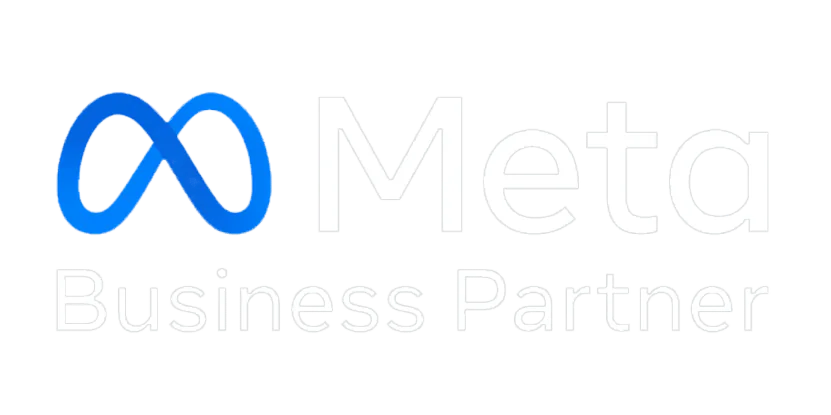How Fitness & Wellness Brands Like 2X Nutrition Are Growing Faster with WhatsApp Marketing
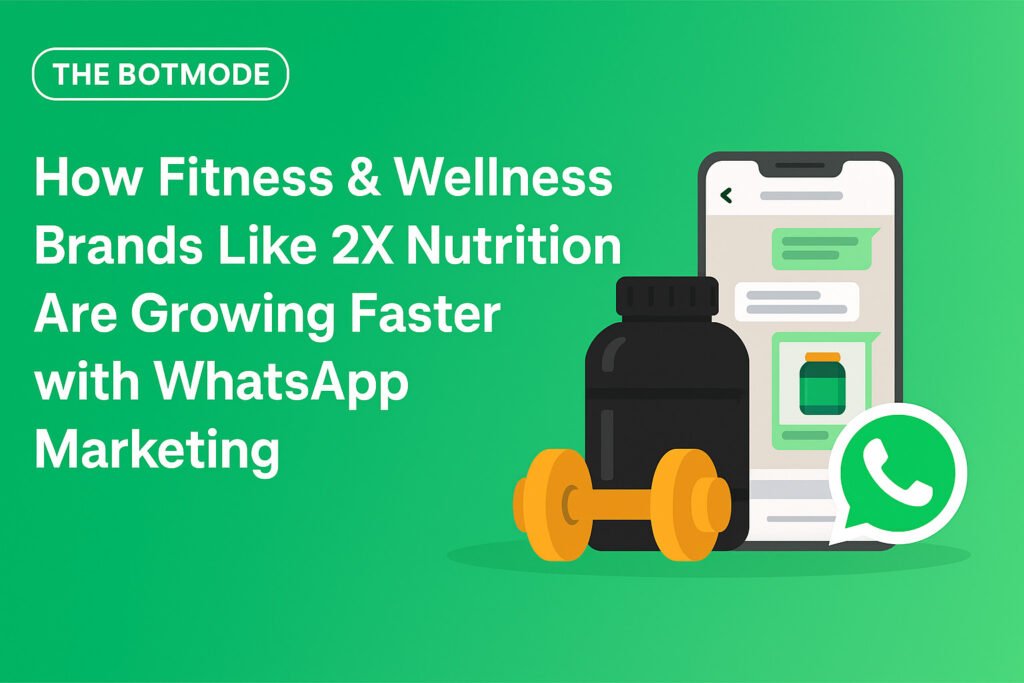
Introduction The fitness and wellness industry has seen massive digital transformation in recent years. Customers are no longer walking into gyms or health stores to make decisions — they’re scrolling, tapping, and chatting online. In this new era, WhatsApp has become the most powerful channel for fitness brands to build real relationships. From promoting supplements to sending personalized workout reminders, brands like 2X Nutrition are using The BotMode’s WhatsApp automation platform to connect with customers in a direct, conversational way — and the results are exceptional. The Fitness Industry Challenge: High Abandonment, Low Engagement Every D2C brand in the wellness space faces a common set of challenges: With health and nutrition products like protein powders, vitamins, or meal replacements, the decision cycle is short — but retention is everything. Brands need to re-engage users fast, with the right message, at the right time. That’s where WhatsApp marketing automation comes in. Why WhatsApp Works Best for Fitness & Wellness Brands How 2X Nutrition Uses The BotMode to Scale with WhatsApp 2X Nutrition, one of India’s fastest-growing fitness brands, sells high-quality supplements, proteins, and vitamins to thousands of athletes and gym-goers. But like most D2C brands, they faced: After integrating The BotMode, they automated the entire customer journey: 1. Cart Recovery Automation When a user adds a product to cart but doesn’t checkout, The BotMode automatically sends a reminder after 30 minutes with a personalized offer — resulting in a 25–30% recovery rate. 2. Subscription & Reorder Reminders The system tracks the average consumption cycle (e.g., protein refills every 30 days) and sends timely WhatsApp reminders — boosting repeat purchase rates significantly. 3. Order Updates & Delivery Notifications WhatsApp messages keep customers informed with real-time shipping and delivery updates, improving transparency and reducing RTOs for COD orders. 4. Upsell & Cross-Sell Campaigns When a customer buys Whey Protein, The BotMode suggests Creatine or BCAA in follow-up messages — driving higher AOV (Average Order Value). TheBotMode Advantage for Wellness Businesses Unlike generic marketing tools, The BotMode is built specifically for D2C and eCommerce brands.Here’s why it’s the preferred choice for fitness and wellness startups: Feature How It Helps Fitness Brands Shopify/WooCommerce Integration Auto-sync your product catalog and customer data Smart AI Segmentation Send the right message to the right user (e.g., “repeat buyers” vs “first-time visitors”) Automated Workflows Trigger WhatsApp messages for cart recovery, order tracking, or feedback COD Verification Reduce fake or undelivered orders through instant WhatsApp confirmation Performance Analytics Track ROI, conversion, and message performance in real time Results That Speak for Themselves Brands using The BotMode typically achieve: For 2X Nutrition, WhatsApp became their most cost-efficient marketing channel — enabling direct, measurable revenue without complex ad campaigns. Top WhatsApp Campaign Ideas for Fitness Brands How to Get Started with WhatsApp Marketing Conclusion In the fitness and wellness space, growth isn’t just about selling — it’s about building trust, consistency, and personalized experiences. With The BotMode’s WhatsApp marketing platform, brands like 2X Nutrition have proven that direct, conversational communication can transform casual buyers into loyal fitness advocates. If you’re a D2C brand in the health, supplement, or wellness industry — now is the time to make WhatsApp your strongest growth channel. Book a free demo on TheBotMode.com and start scaling your brand today. FAQs Q1. How can fitness brands use WhatsApp for marketing? Fitness brands can send personalized product recommendations, promote challenges, recover carts, and automate reorders — all through WhatsApp automation. Q2. Is WhatsApp marketing better than email for wellness brands? Yes. WhatsApp has a 90%+ open rate and faster response times, making it ideal for direct engagement. Q3. What are some best practices for WhatsApp marketing in the fitness industry? Use conversational tone, segment your audience, personalize offers, and keep compliance with Meta’s policies. Q4. Can small fitness studios or personal trainers use WhatsApp Business API? Absolutely. The BotMode offers easy onboarding for both small studios and large D2C brands.
From Chat to Checkout: WhatsApp Marketing Funnels for D2C Brands
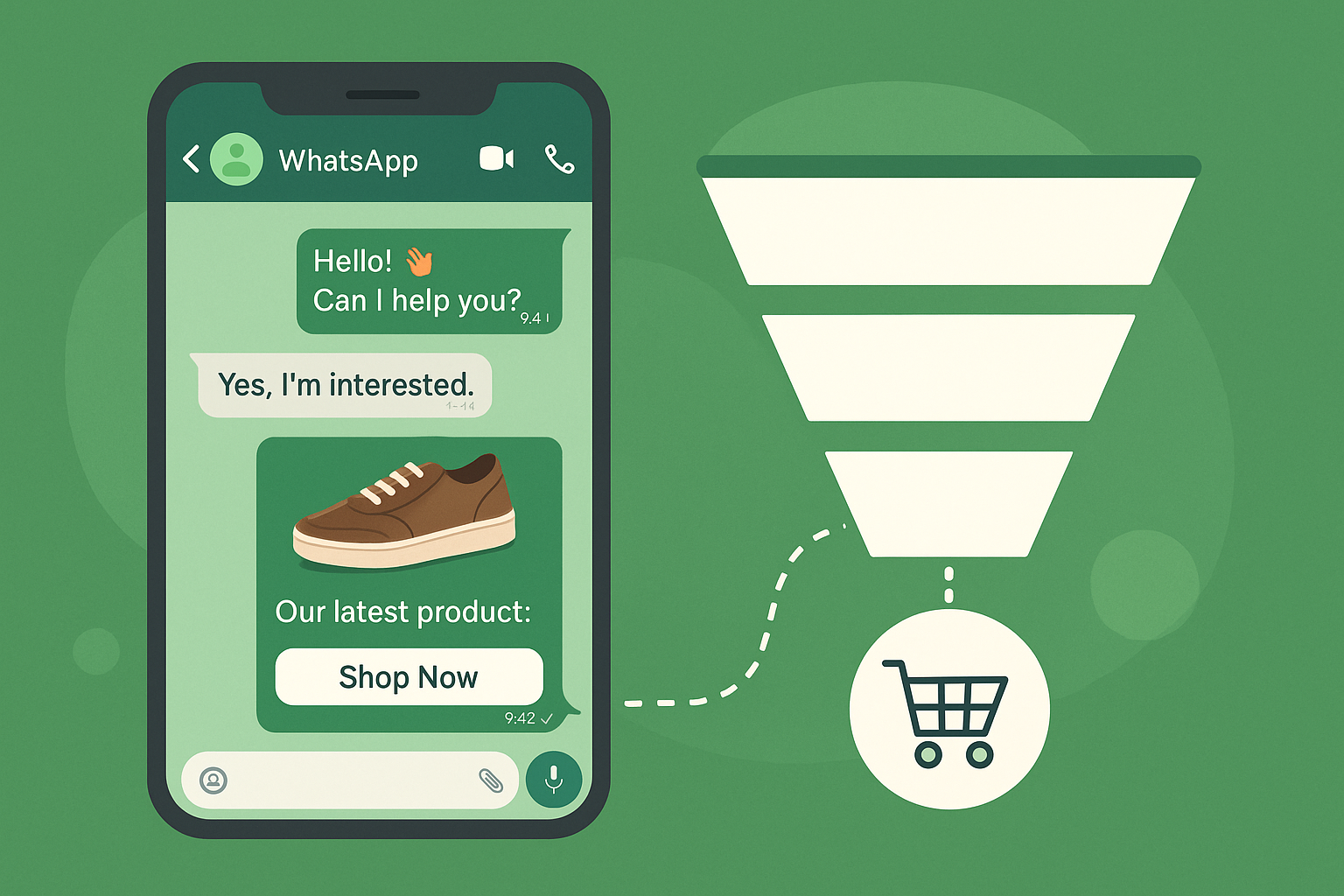
Introduction In 2025, WhatsApp is no longer just a messaging app—it’s becoming a powerful commerce engine. For D2C brands, the real magic lies in turning chats into conversions. Imagine a potential customer clicks “Chat with us,” immediately engages in conversation, and completes the purchase—all without ever leaving WhatsApp. That’s the essence of a well-built WhatsApp marketing funnel. In this blog, we’ll walk you through how D2C brands can structure, optimize, and scale a WhatsApp funnel—from discovery to retention. We’ll cover strategies, tools, real‑world tips, and pitfalls to avoid. 1. Why WhatsApp Funnels Are Ideal for D2C Brands 2. The WhatsApp Funnel Stages (Chat → Checkout Pathway) Here’s a breakdown of key funnel stages in WhatsApp marketing for D2C brands: Stage Purpose Key Tactics 1. Entry / Discovery Get people to initiate chat Click‑to‑WhatsApp ads, website CTA, QR codes, “Chat now” buttons 2. Qualification & Engagement Understand user needs, segment them Automated flows, quick replies, menus, prompting questions 3. Product Showcase & Offer Present product(s) & value Catalogs, carousels, images + brief descriptions, personalized offers 4. Checkout & Payment Facilitate the actual purchase In‑chat payment links, UPI, card integrations, redirecting strategically 5. Post‑Purchase & Retention Nurture for loyalty & repeat Order updates, feedback, cross-sell, drip flows, reactivation nudges Let’s go deeper into each. 2.1 Entry / Discovery 2.2 Qualification & Engagement Once a user messages, an automated flow or chatbot should: This step helps you segment the user (e.g. new vs returning, product interest) and provide tailored messaging downstream. 2.3 Product Showcase & Offer Because the user is already engaged, they’re more likely to act on offers within the same flow. 2.4 Checkout & Payment This is the pivotal moment: The goal: minimize friction and avoid forcing the user to leave the chat unless absolutely necessary. 2.5 Post-Purchase & Retention Even after conversion, the funnel continues: This helps convert one-time buyers into repeat customers. 3. Common Mistakes & How to Avoid Them Conclusion WhatsApp funnels are redefining how D2C brands convert and retain customers. The advantage? You meet your audience where they already are—chat—and carry them gently toward purchase, all within a single app. To build your funnel: If you blend smart tech, human touch, and data-driven iteration, you’ll convert more chats into checkouts—and build loyalty along the way. FAQs Q: What is a WhatsApp marketing funnel for D2C brands? A: It’s a structured chat-based path—from first message to purchase—designed to engage, convert, and retain customers within WhatsApp. Q: Can a D2C brand sell directly in WhatsApp? A: Yes, using the WhatsApp Business API + catalog/payment integrations, brands can let users browse and pay without leaving chat. Q: What tools should D2C brands use for WhatsApp funnels? A: Choose a BSP (e.g., AiSensy, Kommunicate, Zoko) that supports automation, CRM integration, templates, analytics, and fallback options. Q: How often can you message customers on WhatsApp? A: Be cautious. Stick to 1–2 promotional sends per week unless they re-engage. Use templated messages and respect WhatsApp’s 24‑hour window rules. Q: How do you measure ROI in WhatsApp funnels? A: Track metrics like delivery rate, open rate, click-through rate, conversion rate, opt‑outs, and cost per conversion. Compare revenue generated vs messaging and tool costs.
Turning First‑Time Buyers Into Lifetime Fans: D2C Edition
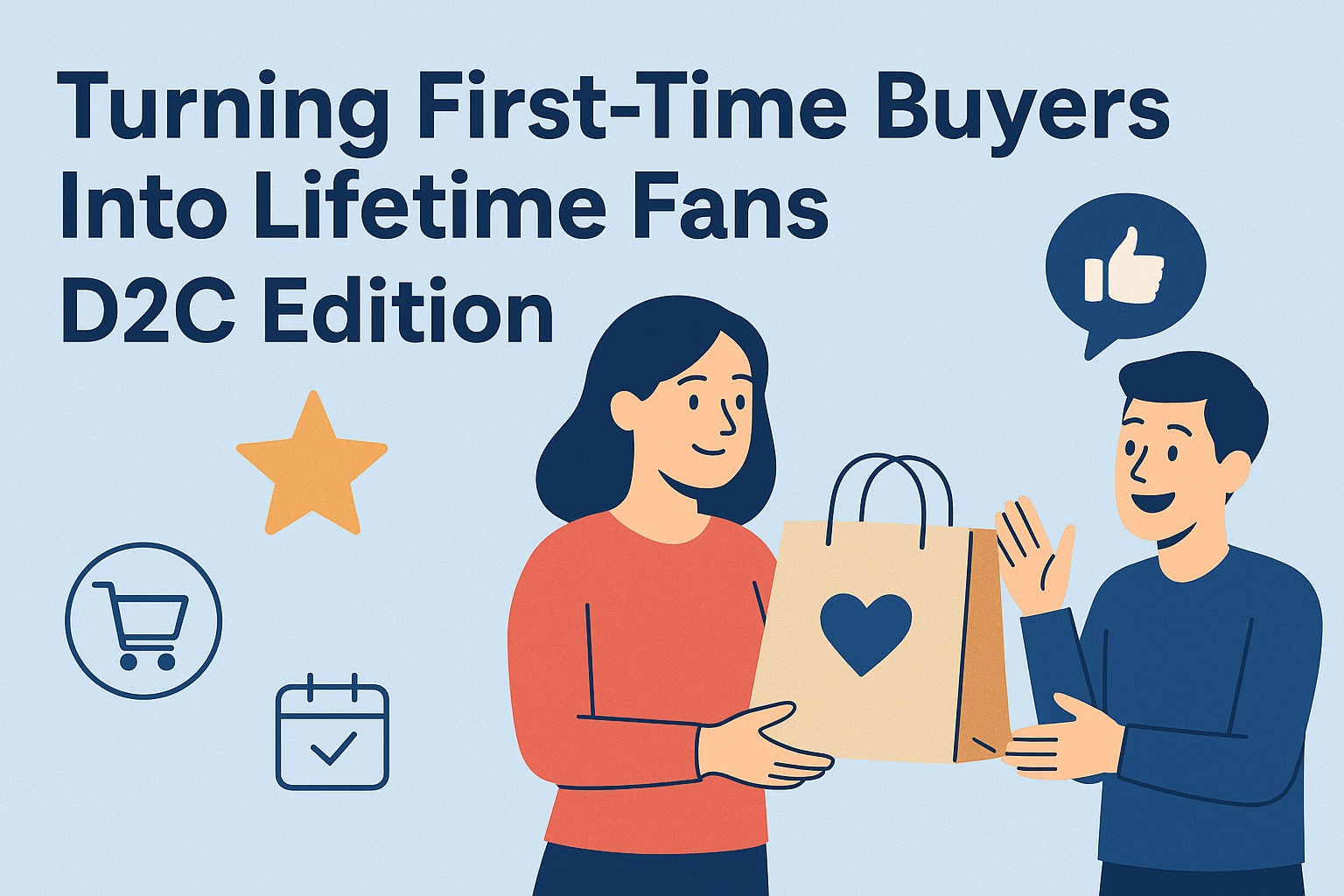
Introduction In today’s D2C landscape, acquiring a customer is just the beginning. The real challenge—and opportunity—lies in converting that one-time buyer into a lifelong fan who not only returns but also advocates for your brand. For D2C brands, this shift from transaction to relationship is essential to achieving long-term growth, reducing acquisition costs, and building community-driven brand equity. 1. Deliver an Exceptional Post‑Purchase Experience The buyer journey doesn’t end at checkout—it starts a new phase. 2. Personalize Every Interaction Customers expect relevance. Data helps make that happen. 3. Build a Loyalty Program That Feels Valuable Loyalty should go beyond points. Make it meaningful. 4. Create a Community, Not Just a Customer List Communities build brand love—and trust. 5. Support That Goes Beyond Solving Problems Customer service should feel like customer care. 6. Re-Engage Lapsed Customers Proactively Retention doesn’t mean passive waiting—it means smart reactivation. 7. Measure & Optimize for Loyalty Track the right metrics to stay ahead. Case Snapshot: D2C in Action A home fitness D2C brand launched an onboarding email series post-purchase, invited customers to a private fitness community, and offered rewards for workout video submissions. The result? Conclusion D2C brands must prioritize retention as much as acquisition. Turning a first-time buyer into a lifetime fan means creating a journey filled with personalization, care, community, and continuous value. When you treat customers like people—not transactions—they return the favor with loyalty. FAQs Q1: What is the most important step to retain first-time D2C buyers? A: The post-purchase experience. It sets the tone for your brand relationship—make it exceptional, personalized, and supportive. Q2: How can small D2C brands afford to create loyalty programs? A: Start simple—offer discounts on second purchases or early access to sales. Use low-cost tools and scale as you grow. Q3: How do I know if my customers are becoming loyal fans? A: Track repeat purchase rates, referral activity, customer reviews, and engagement metrics like email opens and community participation. Q4: Is community really necessary for all D2C brands? A: While not mandatory, community adds significant brand equity. Even small efforts like private social groups or shared hashtags can increase retention and advocacy. Q5: What if a customer has a bad first experience? A: Address it immediately with proactive support, make it right, and offer a personal gesture of goodwill. You can often turn a poor experience into a loyalty opportunity.
Latest WhatsApp Business Statistics That Matter in 2025
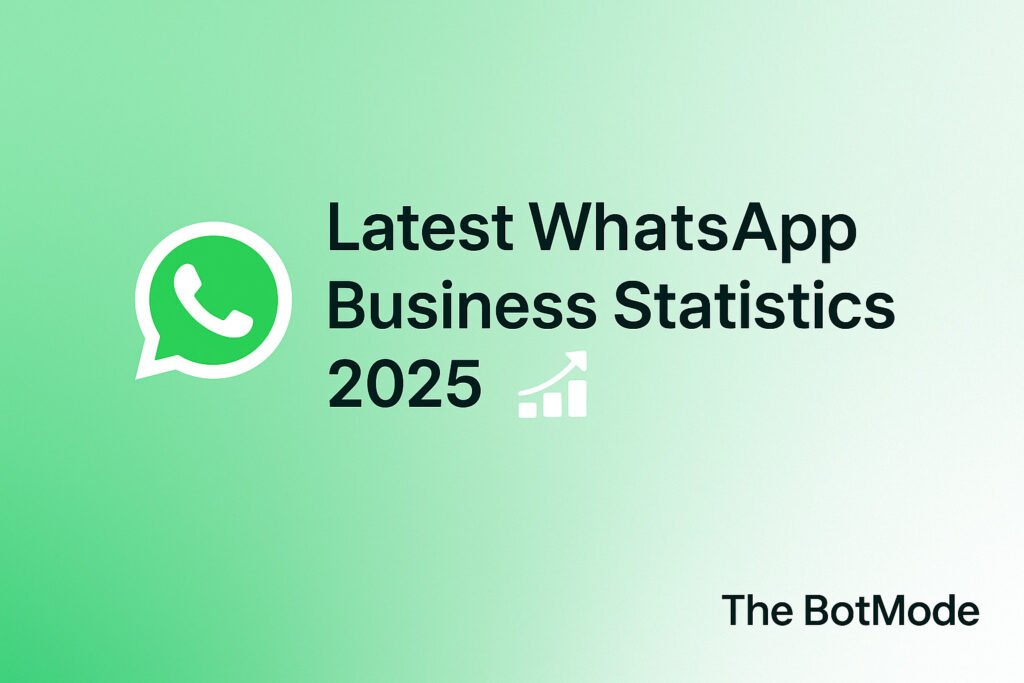
Introduction: In 2025, WhatsApp Business isn’t just a messaging tool—it’s the backbone of customer engagement for millions of brands worldwide. With over 2.8 billion global users and business adoption surging across industries, WhatsApp remains the most effective way for D2C, eCommerce, and SMBs to connect with customers. This blog brings you the latest WhatsApp Business statistics for 2025, highlighting trends that matter and showing how The BotMode helps brands turn these numbers into growth. WhatsApp User Statistics 2025 Insight for Brands: If your business isn’t on WhatsApp in 2025, you’re missing the single most engaged audience in digital marketing. WhatsApp Business App Adoption The BotMode Advantage: By integrating Shopify, WooCommerce, and CRM, brands can move beyond the basic app to scalable API-based automation. WhatsApp Commerce & Revenue Stats The BotMode Insight: D2C brands using WhatsApp Broadcast, abandoned cart recovery, and upsell campaigns see 15–30% revenue uplift within 60 days. WhatsApp Broadcast & Campaign Stats AI & Automation in WhatsApp (2025 Trend) The BotMode Edge: With AI-powered WhatsApp automation, brands personalize conversations at scale—like recommending products based on purchase history. Regional WhatsApp Business Adoption Why These Statistics Matter for Your Business FAQs Q1. How many businesses use WhatsApp in 2025? Over 200 million businesses globally use WhatsApp Business, with adoption highest in India, Brazil, and Southeast Asia. Q2. Is WhatsApp better than SMS or email for campaigns? Yes. WhatsApp has higher open (98%) and response rates, interactive features, and personal delivery that SMS/email can’t match. Q3. What’s the role of AI in WhatsApp Business in 2025? AI powers chatbots, smart scheduling, and personalized campaigns—boosting efficiency and conversions. Platforms like The BotMode lead this shift. Conclusion The latest statistics prove one thing: WhatsApp Business is no longer optional—it’s essential. With billions of users, unmatched engagement, and proven commerce success, brands that master WhatsApp in 2025 will stay ahead. And with The BotMode, you get automation, personalization, compliance, and analytics—all in one growth platform. Ready to leverage WhatsApp in 2025? Book your free demo with The BotMode and turn these stats into real business growth
WhatsApp Broadcast for Business: The Complete Guide for D2C Brands
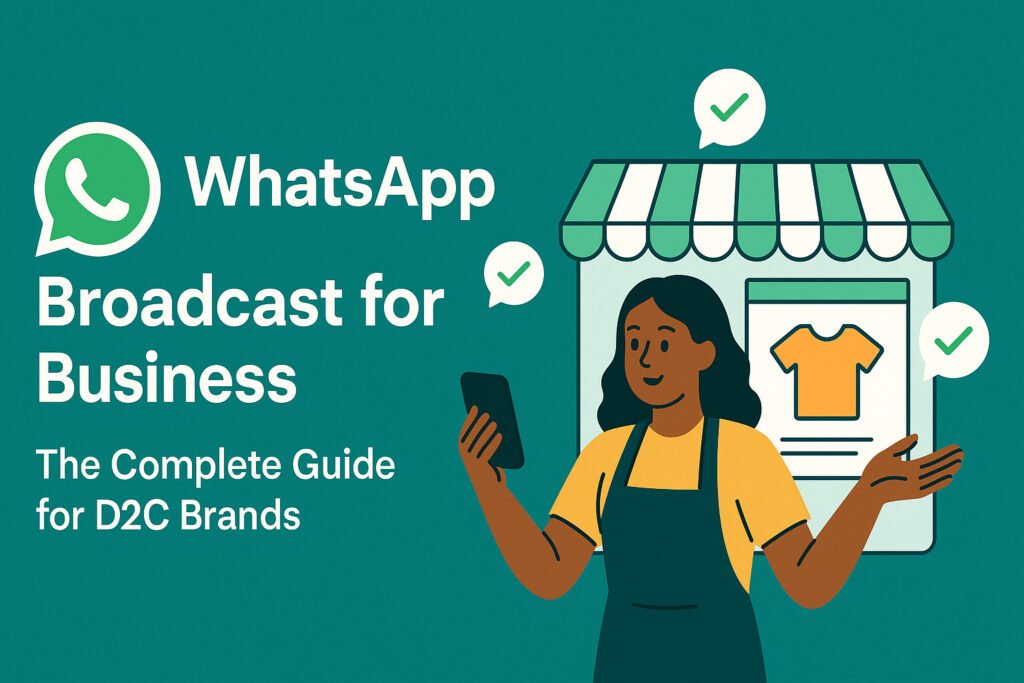
Introduction Today’s customers are scroll-fatigued and notification-blind. Emails get buried, SMS feels spammy, but WhatsApp has become the most direct and personal business channel with over 2.7 billion active users worldwide. For D2C brands, WhatsApp Broadcast offers a powerful way to: With The BotMode, you can automate, personalize, and scale your WhatsApp Broadcast campaigns while staying fully compliant with WhatsApp’s rules. What is WhatsApp Broadcast? A WhatsApp Broadcast lets businesses send a single message to multiple users at once — without creating a group. Example: A clothing brand sends a broadcast—“New festive collection is live 🎉 Click here to shop before stocks run out!” Why Use WhatsApp Broadcast for Business? 1. High Engagement Open rates exceed 90%, far higher than email (20–25%) or SMS (10–15%). 2. Personalized Messaging With The BotMode, you can insert dynamic fields like customer name, last order, or location. 3. Multi-Use Cases 4. Interactive Experience Send catalogs, quick-reply buttons, and call-to-action (CTA) messages directly inside WhatsApp. WhatsApp Broadcast vs WhatsApp Group Feature Broadcast Group One-to-many messaging ✅ Yes ✅ Yes Privacy (others can’t see) ✅ Yes ❌ No Professional use ✅ Ideal ❌ Limited Automation support ✅ With API ❌ No Clearly, Broadcast > Group when it comes to scaling business communication. How WhatsApp Broadcast Works with The BotMode Best Practices for WhatsApp Broadcast Campaigns WhatsApp Broadcast Compliance Rules WhatsApp has strict policies: The BotMode ensures all broadcasts are 100% compliant with WhatsApp Business API rules. Real Business Example A D2C wellness brand used The BotMode to send a festival broadcast announcing “Buy 1 Get 1 Free” on supplements. FAQs Q1. How many people can I reach with WhatsApp Broadcast? With the WhatsApp Business API (via The BotMode), you can reach unlimited customers, unlike the 256-contact limit of the free WhatsApp app. Q2. Can I personalize WhatsApp Broadcast messages? Yes, The BotMode allows you to insert dynamic tags like customer name, order ID, or last purchased product. Q3. Is WhatsApp Broadcast free? No. It follows a conversation-based pricing model set by Meta. The BotMode provides transparent rates with minimal markup. Conclusion WhatsApp Broadcast is more than a marketing tool — it’s a direct sales channel. When paired with automation, segmentation, and AI personalization via The BotMode, it becomes your brand’s secret weapon to boost engagement, increase revenue, and build loyalty. 🚀 Ready to scale your outreach? Book a free demo with The BotMode and start broadcasting smarter today.
Unlock Growth with WhatsApp Upsell & Cross-Sell Campaigns: The Complete Guide for D2C Brands
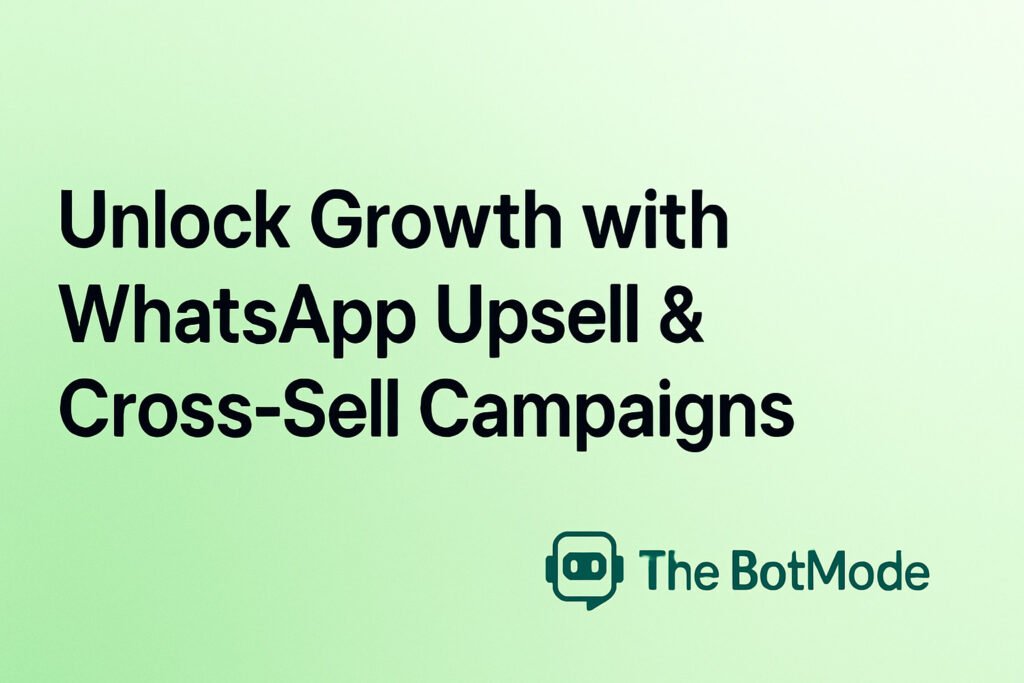
Introduction For D2C brands, average order value (AOV) and repeat purchases are two critical growth levers. Traditional email or SMS campaigns often get ignored, but WhatsApp has become the most engaging commerce channel with open rates above 90%. This makes it the perfect platform for upselling (encouraging customers to buy a higher-value product) and cross-selling (suggesting complementary products). With The BotMode, you can run automated WhatsApp upsell and cross-sell campaigns that not only drive revenue but also feel like natural conversations. What is WhatsApp Upselling? Upselling is convincing a customer to purchase a higher-end, upgraded, or premium version of the product they are already considering. Example: A customer adds a basic protein powder to their cart → you send a WhatsApp message suggesting the advanced protein blend with more nutrients. Benefits of Upselling on WhatsApp: What is WhatsApp Cross-Selling? Cross-selling is recommending related or complementary products to the one a customer has bought or is considering. Example: A customer buys running shoes → you send a WhatsApp message recommending moisture-wick socks or a fitness smartwatch. Benefits of Cross-Selling on WhatsApp: Why Use WhatsApp for Upsell & Cross-Sell Campaigns? Unlike email or SMS, WhatsApp provides real-time, interactive, and personalized communication. Proven WhatsApp Upsell & Cross-Sell Strategies 1. Post-Purchase Upsell Send a follow-up WhatsApp message after purchase:“Thanks for your order Customers who bought this also loved [Product X]. Want me to add it to your order?” 2. Abandoned Cart with Upsell Instead of a generic cart reminder, send:“You left [Product A] in your cart. Upgrade to [Premium A+] today at 10% off!” 3. COD Order Confirmation with Cross-Sell Confirm the order via WhatsApp and add:“Would you like to add [Accessory/Product B] with free shipping to your order?” 4. Personalized Recommendations Use purchase history to suggest new arrivals:“Hi [Name], since you loved our [Category], we think you’ll enjoy [New Collection].” 5. Limited-Time Bundles Offer bundle deals on WhatsApp:“Get [Product A + Product B] together at 15% off. Offer valid till midnight.” How The BotMode Makes Upselling & Cross-Selling Easy With The BotMode, D2C brands can set up: Instead of sending generic messages, The BotMode ensures each customer receives the right product recommendation at the right time. Real-World Example A D2C skincare brand using The BotMode ran WhatsApp upsell campaigns targeting customers who bought face wash. They suggested adding moisturizer or upgrading to a skincare kit. Best Practices for WhatsApp Upsell & Cross-Sell FAQs Q1. Can I automate WhatsApp upsell campaigns? Yes. With The BotMode, you can set triggers like purchase, delivery, or abandoned cart to automatically send upsell/cross-sell offers. Q2. How are WhatsApp campaigns better than email upselling? WhatsApp has higher open & response rates, allows interactive product cards, and delivers a personal shopping assistant experience. Q3. Is this allowed under WhatsApp Business Policy? Yes. As long as you use pre-approved WhatsApp templates and comply with user consent guidelines. Conclusion Upsell and cross-sell campaigns are not just sales tactics — they are ways to add value for customers. With The BotMode, your brand can leverage WhatsApp’s high engagement, AI-driven personalization, and automation to unlock higher order values and repeat sales. Ready to start? Book a free demo with The BotMode and see how WhatsApp can boost your growth.
Best WhatsApp Marketing Tool in 2025: A Complete Guide for Businesses
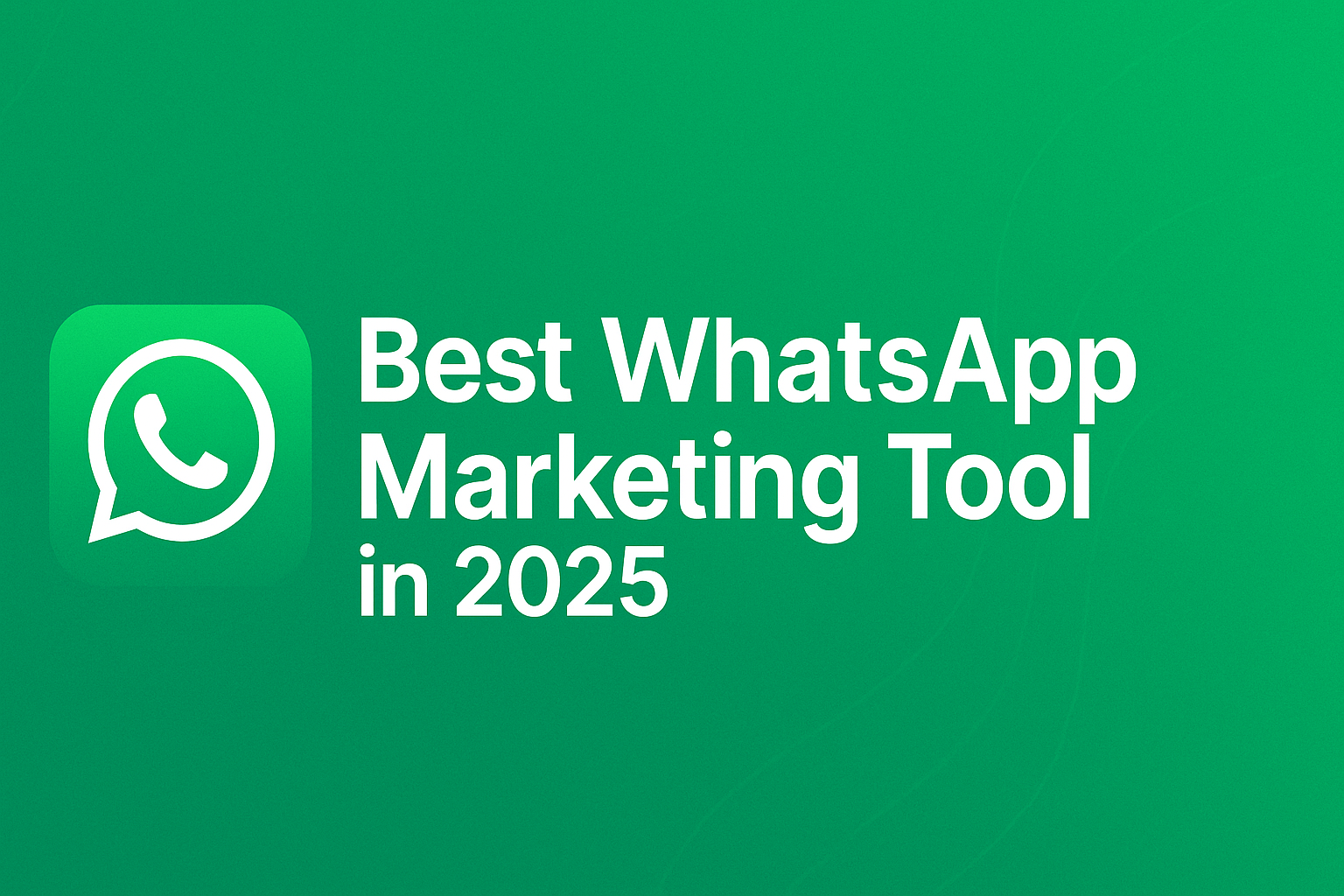
Introduction: Why Choosing the Best WhatsApp Marketing Tool Matters WhatsApp has become the backbone of customer communication for businesses worldwide. From D2C brands to enterprises, the right WhatsApp marketing tool can improve conversions, reduce RTOs, and build lasting customer trust. But with dozens of providers in the market, one question stands out: Which is the best WhatsApp marketing tool in 2025? Let’s compare the top options. TheBotMode — The AI-Powered WhatsApp Marketing Tool for D2C Brands TheBotMode is redefining WhatsApp marketing by going beyond bulk messaging. Built for D2C and eCommerce brands, it focuses on AI-driven automation, personalization, and revenue optimization. Key Features of TheBotMode: Best For: Top WhatsApp Marketing Tools in 2025 1. TheBotMode 2. AiSensy 3. WATI 4. Gupshup 5. Interakt Quick Comparison Table (2025) Tool Best For Strengths Weaknesses TheBotMode D2C, Shopify, WooCommerce AI smart scheduling, RTO reduction, commerce-first automation Newer player, growing adoption AiSensy SMBs, startups Broadcasts + automation Higher pricing at scale WATI Agencies, SMBs Chatbot builder, team inbox Costlier than local tools Gupshup Enterprises Global API power Steeper learning curve Interakt D2C SMBs CRM + affordable plans Less automation depth How to Pick the Best WhatsApp Marketing Tool for Your Business The best tool depends on your business model, scale, and priorities: FAQs Q1: Which is the best WhatsApp marketing tool for D2C brands in India? 👉 TheBotMode is designed specifically for D2C, with AI flows, COD verification, and Shopify/WooCommerce integrations. Q2: What’s the cheapest WhatsApp marketing tool? 👉 Interakt offers entry-level affordability, but TheBotMode balances cost with AI-driven features. Q3: Is WhatsApp marketing legal? 👉 Yes — but only if you use official WhatsApp Business API providers like TheBotMode, AiSensy, or WATI. Q4: Which WhatsApp tool is best for reducing RTOs? 👉 TheBotMode stands out with RTO-focused flows, COD verification, and delivery reminders.
From Broadcast to Conversion: WhatsApp Message Marketing for D2C Brands
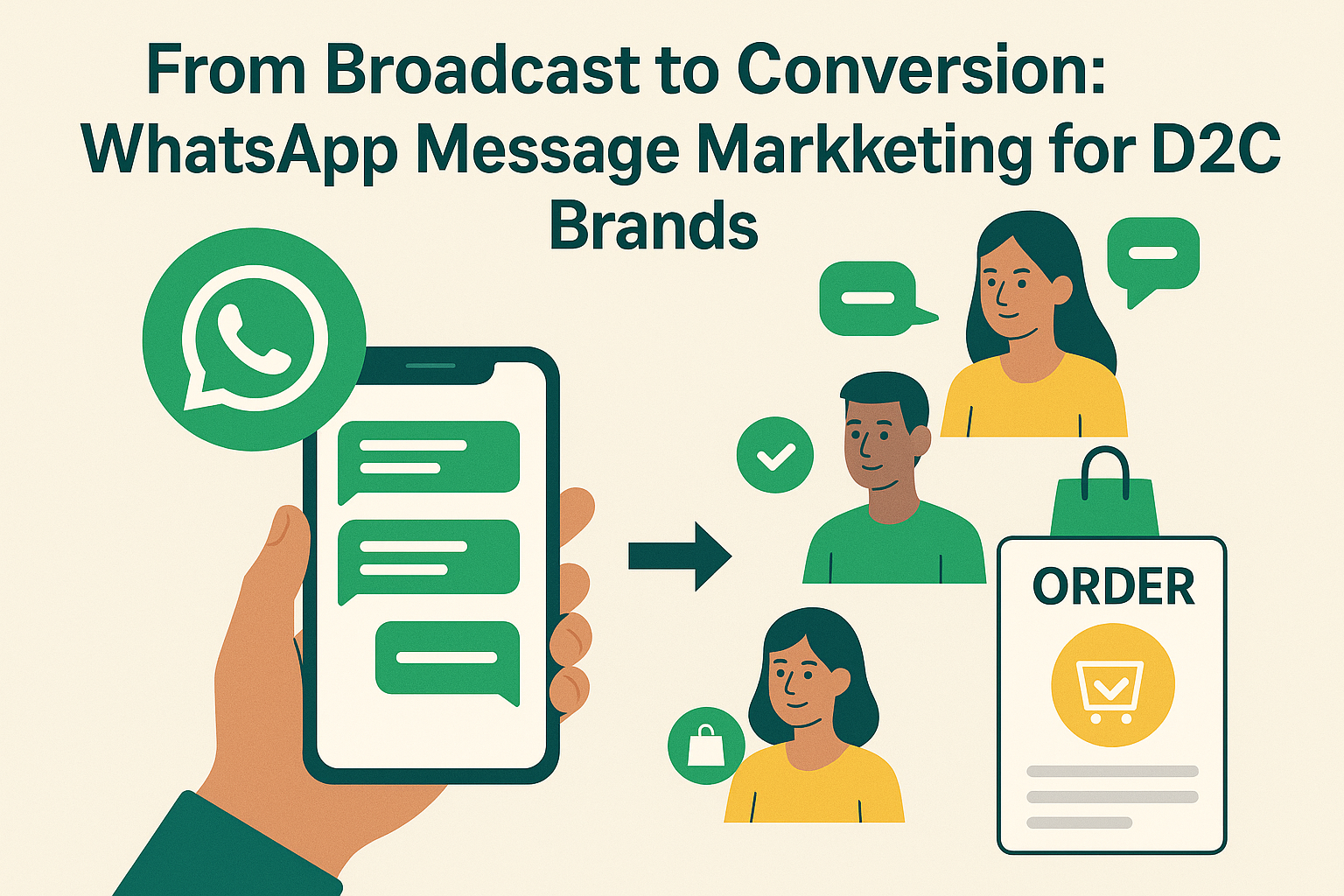
Introduction In a crowded digital space, D2C brands face rising customer acquisition costs, low email engagement, and waning SMS effectiveness. But there’s one channel that’s defying these trends: WhatsApp message marketing.With open rates nearing 98% and click-throughs that dwarf traditional channels, WhatsApp is fast becoming a critical tool for D2C brands aiming to convert broadcasts into real revenue. In this post, you’ll learn how to structure your WhatsApp approach — from opt-in to broadcast to conversion flows — backed by strategies, templates, and metrics designed especially for D2C brands. From Broadcasters to Converters: Strategy Framework 1. Opt‑in & Subscriber Growth 2. Crafting Broadcasts That Engage (Not Annoy) 3. Automations & Sequences 4. Click‑to‑WhatsApp & Conversational Funnels Case Studies & Examples (If you like, I can fetch brand names and numbers for your niche.) Implementation Roadmap for D2C Brands Phase Focus Actions Phase 1 Setup & compliance Apply for API access, approve templates, collect opt-ins Phase 2 Pilot broadcasts & flows Run test campaigns, simple flows Phase 3 Segment & automate Build more audience segments, more sequences Phase 4 Optimize & scale A/B testing, refine copies, scale budgets Also consider tools or platforms that ease the integration, automation, analytics — and always track link-level metrics for attribution. Conclusion Broadcasts are the starting point — the real power of WhatsApp marketing lies in conversion-focused flows, personalization, and automation. For D2C brands, WhatsApp can become a core channel for engagement, sales, and retention. If you want to see how we implement WhatsApp strategies for D2C brands or scale message marketing, check out how we help at The BotMode. FAQs How often should a D2C brand send WhatsApp broadcasts? 1–3 high-value messages per week is a good benchmark. Overdoing it can lead to opt-outs. Will customers find WhatsApp marketing intrusive? Not if they opted in and messages are relevant, timely, and conversational. Always include opt-out choice. Which is better: WhatsApp or email marketing for D2C? WhatsApp often outperforms email in open and click-through rates, but they complement each other — use both. How many messages per month is safe before unsubscribes rise? It depends on your niche and content quality, but exceeding 10–12 generic blasts monthly is risky — always monitor opt-out rates. Can small D2C brands with limited budgets use WhatsApp message marketing? Yes — start small with basic broadcasts or transactional flows, use affordable API platforms, reinvest returns, and gradually scale.
How D2C Brands Can Win with WhatsApp Business Marketing
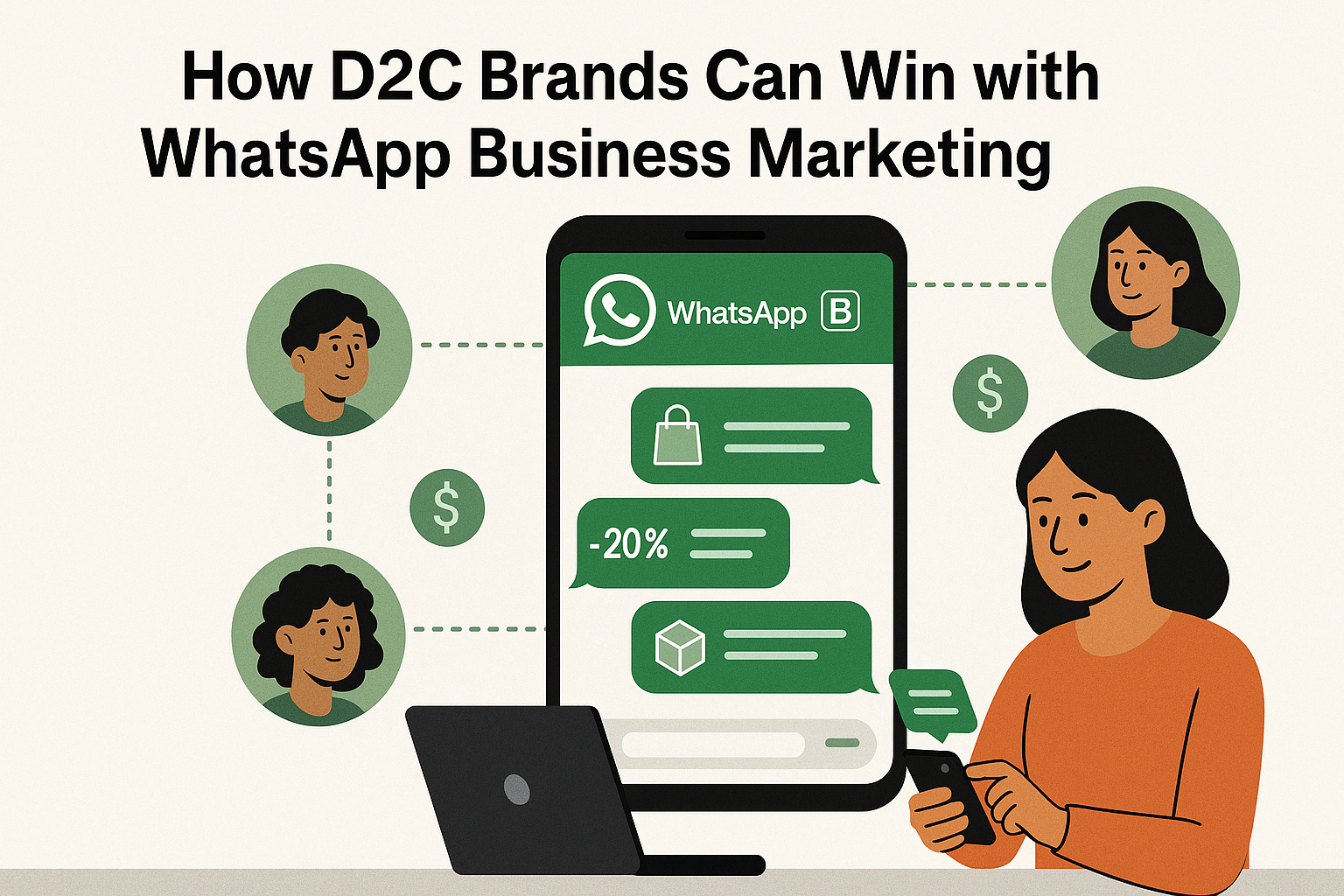
Introduction Did you know WhatsApp messages enjoy an open rate of nearly 98%, far surpassing email and SMS? For Direct-to-Consumer (D2C) brands, this makes WhatsApp an untapped goldmine for building stronger customer relationships, driving engagement, and boosting sales. In today’s world where acquisition costs are soaring and customer attention spans are shrinking, WhatsApp Business offers a direct, personal, and conversational channel that meets consumers where they already are—on their phones. This blog will explore how D2C brands can harness WhatsApp Business for marketing success, diving into strategies, tools, best practices, KPIs, and real-world case studies. 1. What is WhatsApp Business & WhatsApp Message Marketing? WhatsApp Business is an application (and API) designed to help businesses connect with their audience through one-on-one messaging, automation, and customer support tools. WhatsApp Message Marketing refers to using the platform to send personalized promotions, reminders, updates, and re-engagement messages. Unlike email or SMS, WhatsApp feels personal and conversational, making it especially powerful for D2C brands that thrive on direct customer connections. 2. Why WhatsApp Outperforms Email & SMS for D2C Brands For D2C brands that rely on repeat purchases and community building, these factors give WhatsApp a competitive edge. 3. Winning WhatsApp Business Strategies for D2C Brands 3.1 Segmented Campaigns & Promotions Send tailored messages to customer segments—new customers, loyal buyers, or inactive users.Example: “Hi [Name], your favorite skincare line is back in stock. Shop now!” 3.2 Cart Abandonment Recovery Use reminders to bring shoppers back.Example: “Oops! You left something behind. Complete your order now and enjoy free shipping.” 3.3 Click-to-WhatsApp Ads Run Instagram/Facebook ads that drive users directly into WhatsApp chats. This shortens the funnel and boosts conversions. 3.4 Order Updates & Customer Support Automate transactional messages like confirmations, dispatch, and tracking. Customers appreciate real-time updates. 3.5 Exclusive Offers & Loyalty Rewards Reward WhatsApp subscribers with special discounts or VIP access to launches. 3.6 Collect Reviews & User-Generated Content Request feedback post-purchase and encourage customers to share pictures or reviews. 3.7 Re-engagement Campaigns Re-target inactive users with product suggestions or discounts after 30/60/90 days of inactivity. 4. Measuring Success: Key WhatsApp KPIs 5. Case Studies: WhatsApp in Action for D2C Brands These examples prove WhatsApp can transform marketing outcomes for consumer-driven businesses. Conclusion WhatsApp Business is no longer optional—it’s a must-have for D2C brands that want to connect with customers directly, personally, and effectively. From promotions and cart recovery to loyalty programs and feedback collection, WhatsApp enables brands to drive engagement, sales, and long-term loyalty. 👉 Ready to scale your brand with WhatsApp Business? Start with TheBotMode’s WhatsApp marketing solutions today: Visit TheBotMode. FAQs Q1. Is WhatsApp Business marketing legal? Yes, but you must obtain customer opt-in before sending promotional messages. Q2. How often should D2C brands send WhatsApp messages? 2–4 times per month is safe. Focus on quality and value over frequency. Q3. Can WhatsApp be used for international marketing? Yes. As long as your customers opt in, WhatsApp works globally. Q4. What is the cost of WhatsApp Business API? Pricing varies by provider and country, usually per message.
The Post-Purchase Power: Reducing RTOs by Building Trust with WhatsApp
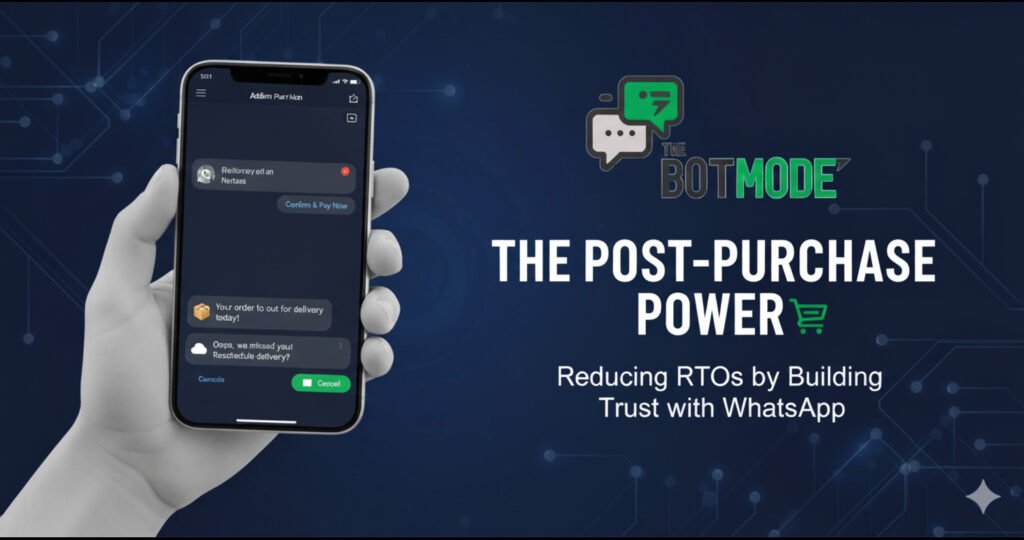
The Silent Killer for D2C Brands: Why RTO Is More Than Just Logistics For any Direct-to-Consumer (D2C) brand, the “buy now” click is a win. But for many brands, especially those relying on Cash on Delivery (COD), this win is short-lived. The culprit? Return to Origin (RTO). RTO isn’t just a logistics headache—it’s a trust problem. Fixing it requires more than courier coordination. The solution lies in proactive post-purchase communication. And the most powerful channel for this is WhatsApp. WhatsApp Marketing for RTO Reduction: Why Communication Matters Traditional brands rely on one dry SMS or email: “Your order has been shipped.” But in 2025, that’s not enough. Building trust is a journey, not a one-time update. Platforms like The Botmode transform WhatsApp into a post-purchase communication engine. Here’s how: 1. Real-Time Order Journey on WhatsApp 2. COD to Prepaid Conversion: Building Trust Through Incentives Since COD orders drive most RTO losses, encouraging prepaid is key. This improves cash flow and slashes RTO risk. 3. Handling Non-Delivery Reports (NDRs) with AI Failed delivery attempts are where most brands give up. But smart WhatsApp automation changes the game: This saves orders from RTO and turns a negative experience into positive customer service. Why The Botmode Is Built for RTO Reduction Unlike generic tools, The Botmode is tailored for D2C brands and ecommerce RTO challenges. Instead of reacting to RTOs, The Botmode helps you prevent them by building trust through personalized WhatsApp marketing. FAQs Q1. What is RTO in ecommerce? RTO (Return to Origin) occurs when a shipped order is returned without delivery, causing extra shipping costs and inventory blocks. Q2. How does WhatsApp help reduce RTO? Through proactive order confirmations, real-time tracking, COD-to-prepaid conversions, and automated NDR handling. Q3. Is RTO a big challenge for D2C brands? Yes, especially for COD orders with 20–30% RTO rates in India. Q4. Can I automate RTO reduction with WhatsApp? Yes. With The Botmode, you can automate the entire journey—from order confirmation to rescheduled deliveries. Q5. Does The Botmode integrate with Shopify? Yes, The Botmode integrates seamlessly with Shopify for real-time automation. Q6. How do I convert COD to prepaid using WhatsApp? By sending a secure payment link with a small incentive (discount, cashback, or freebie) to encourage prepaid completion. Conclusion: RTO reduction isn’t about pushing logistics harder. It’s about building customer trust after purchase. With WhatsApp marketing automation, The Botmode empowers D2C brands to: Ready to see results? Book a free demo with The Botmode today and discover how to reduce return to origin rates and build stronger customer relationships.













